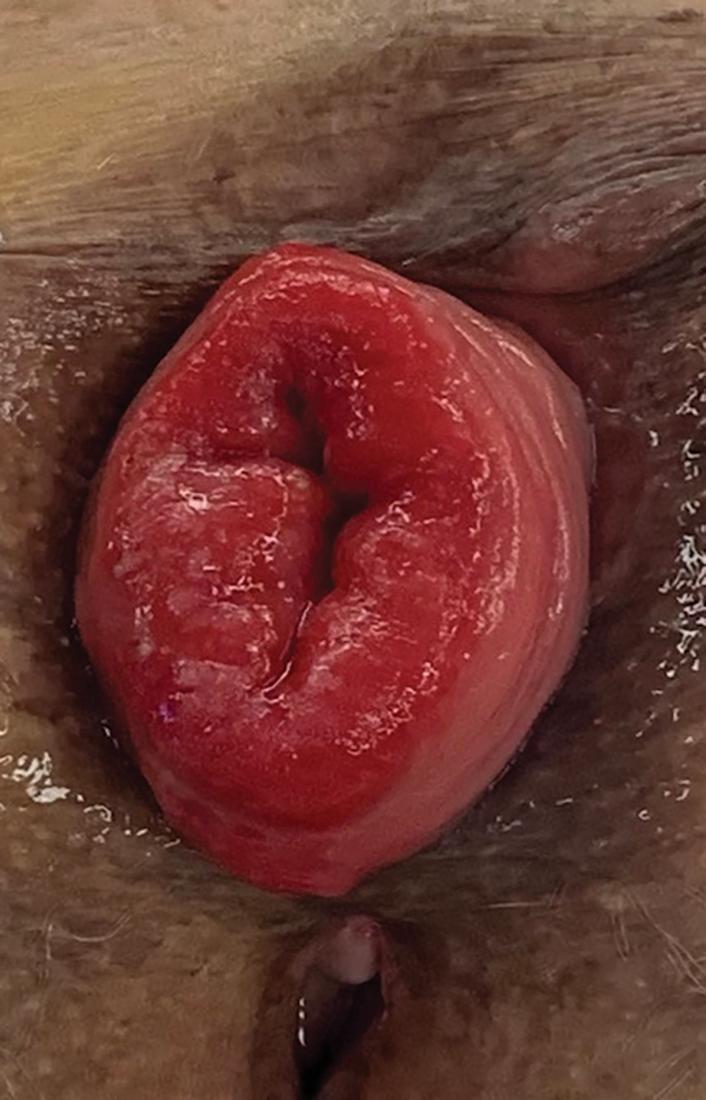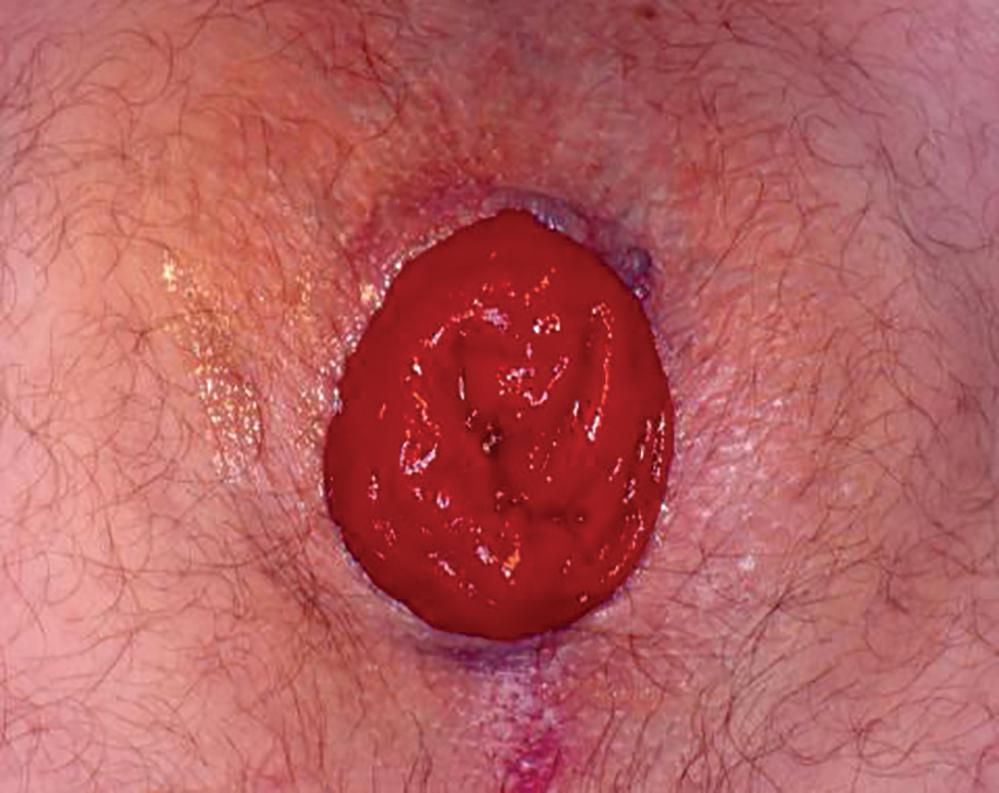Physical Address
304 North Cardinal St.
Dorchester Center, MA 02124
Full-thickness rectal prolapse is a benign but debilitating condition involving full-thickness descent of the rectum through the anal canal ( Fig. 30.1 ). It is important to distinguish full-thickness rectal prolapse from simple prolapse of the rectal mucosa on physical examination ( Fig. 30.2 ). This chapter will focus on full-thickness rectal prolapse. The true cause of rectal prolapse is unknown, despite its long and extensive presence in medical history and literature. Numerous operations have been described in the literature since 1889, when Mikulicz described his series of six patients undergoing perineal excision for prolapse, and great variation in surgical management and approach still exists. In this chapter, we discuss the etiology, epidemiology, clinical features, evaluation, common surgical techniques, results, and our experience regarding rectal prolapse. This is an update from a previous chapter by , incorporating the latest clinical evidence and decision-making.


A renowned English colorectal surgeon, Hugh Lockhart-Mummery of St. Marks’ Hospital in London, wrote in 1972: “It is interesting to note that we still know so little about the cause of such a common condition.” The most current and accepted theory was proposed by after they demonstrated with cinedefecography that full-thickness prolapse starts as an internal intussusception of the rectum with a lead point proximal to the anal verge. Years later, radiopaque markers were applied to the rectal mucosa in studies to demonstrate this phenomenon in real time and support the current theory that rectal prolapse is attributed to internal intussusception of the rectal wall.
There are many common anatomic features that may relate to rectal prolapse: a deep peritoneal cul-de-sac or pouch of Douglas, enterocele, loss of posterior rectal fixation, a patulous anal sphincter, diastasis of the levator ani, redundant rectum and sigmoid colon, and loss of the rectum’s horizontal position may all contribute to the pathology. It is unclear whether these findings are a cause of the rectal prolapse, or if they are merely associated abnormalities. The goals of any operation to repair rectal prolapse should be to correct the prolapse of tissue, avoid worsening any concurrent issues such as incontinence or constipation, and avoid causing new problems, particularly new-onset constipation.
Rectal prolapse is a relatively uncommon phenomenon, occurring in an estimated 0.5% of the population; however, the true incidence and prevalence are unknown, primarily because of underreporting, especially in the elderly population. The peak incidence is in the seventh decade of life, and it occurs more commonly in women, who are six times more likely to suffer from prolapse than are men ( ). Although rectal prolapse is often associated with multiparity, nearly one-third of women with rectal prolapse are nulliparous. Male patients, although they represent a very small portion of this population, generally develop prolapse at a younger age than female patients (<40 years). There is also an association between younger presentation and psychiatric conditions requiring multiple medications, such as autism and developmental delay.
Patients with rectal prolapse generally present with fecal soilage, prolapse of tissue through the anal sphincter complex, mucoid discharge, and bleeding. Although the precise pathophysiology is unclear, found that 18% of patients with prolapse reported straining, and 42% had constipation as the most common associated symptom.
A complete assessment of female patients with rectal prolapse should include evaluation for constipation, urinary and fecal incontinence, and other pelvic floor disorders such as uterine prolapse, rectocele, cystocele, or enterocele. Staged or combined surgical correction of pelvic floor disorders, should they exist concurrently, is imperative for resolution of symptoms.
Patients are often quite anxious when they present for evaluation for rectal prolapse. After a complete history of the type and duration of symptoms, a simple examination in the office is often sufficient. Symptoms related to fecal and urinary incontinence and constipation should be especially emphasized.
Physical examination entails visual inspection of the perineum, which often reveals a patulous anus. Additionally, mucous soiling of the perineum is often present because of the chronic external prolapse of the rectum. The examiner should be sure to rule out the presence of any palpable masses, and proctoscopy should be done to rule out a malignancy as a potential lead point. If the patient is overdue for a screening colonoscopy, or if symptoms suspicious for cancer are present, they should be referred for colonoscopy before surgical correction of the prolapse. Occasionally, rectal prolapse is not externally visible on initial examination. Examination of the patient in a squatting position or with Valsalva maneuver on a commode may be needed to reproduce the prolapse, but this is a necessary maneuver to distinguish between full-thickness and mucosal prolapse. During inspection, it is important to differentiate full-thickness rectal prolapse (concentric folds) from prolapsing internal hemorrhoids (radial invaginations) (see Figs. 30.1 and 30.2 ). Associated vaginal prolapse such as rectocele (posterior vaginal prolapse), cystocele (anterior vaginal prolapse), or enterocele (prolapse of small intestine, usually at the vaginal apex or posterior vagina) should be identified, if present.
When outlet obstruction or pelvic support disorders are suspected, defecography should be performed. (See Video 13.1 for a detailed description and demonstration of defecography.) This may provide important information like the presence of additional pathology, such as enterocele, rectocele, sigmoidocele, or concomitant vaginal vault prolapse. Additionally, looking at the anorectal angle at rest and straining can be used to assess for appropriate relaxation of the puborectalis muscle and whether or not conditions such as anismus need to be addressed before surgery. Although additional tests such as anal physiology testing can be done, they are typically not necessary in the work-up of an isolated rectal prolapse.
No studies exist that compare operative repair with nonoperative therapy for rectal prolapse, nor are there definitive nonoperative alternatives to correct this condition. Aggressive treatment of constipation, if present, with medications may lessen symptoms. Applying table sugar to the prolapsed segment draws edema out of the segment and may facilitate reduction of the prolapse. Placing the patient in Trendelenburg position and administering intravenous benzodiazepines may ease reduction as well. However, none of these nonsurgical options will definitively repair prolapse, and surgery continues to be the preferred treatment.
Become a Clinical Tree membership for Full access and enjoy Unlimited articles
If you are a member. Log in here